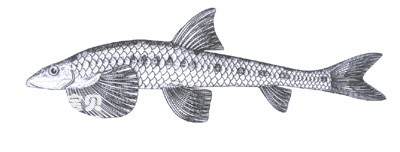Psilorhynchus homaloptera belongs to the order Cypriniformes, the family Psilorhynchus, and the genus Psilorhynchus. Commonly known as: Flatnose fish. English name: Naked-snout carp.
Endangerment level: Endangered.
The body is long and stout, the dorsal fin is curved, the chest and abdomen are straight, the front of the body is flat, the back is flat on the sides, and the caudal peduncle is slender. The head is small and slightly flat. The snout is wide and flat, and the front end is flat and thin. The mouth is small, inferior and broad in width. The muzzle is well developed, with deep grooves on both sides diagonally toward the corners of the mouth. The muzzle, upper lip, and maxilla are separated from each other. The muzzle is downward to cover the upper lip. The upper jaw is exposed, thin and narrow, with soft and transparent edges; the lower jaw is exposed in front of the lower lip. With sharp edge. The skin of the kiss and the narrow area on the edge of the lower lip have small papillae. There is no muzzle barbel, and there is a pair of birch barbels, which are very short and buried in the inner side of the muzzle skin where the upper and lower lips meet. The eyes are slightly smaller. There are 43-46 lateral line scales. The dorsal fin spines are weak and smooth; the even fins are flat, the pectoral fins are wide, with 8-9 unbranched rays; the caudal fin is forked. The back of the body is brown, with 7-10 dark spots along the lateral line, and the abdomen is light in color.

A small fish. It lives in small streams below an altitude of 1,000 meters. It often likes to live in rapids or in the gravel gaps of small rivers. It is an omnivorous fish. Their main food is algae and aquatic invertebrates. The spawning period is around July-August.
This species is distributed in the lower tributaries of the Brahmaputra River in Tibet and is distributed abroad in the Brahmaput River system in India.
The distribution of this species in my country is limited to a small range in remote areas, and its population is sparse. It has high requirements on environmental conditions and must live in clear running water bodies in mountain streams or small tributaries of rivers. It is not suitable for turbid water bodies containing sediment. In recent years, due to the felling of forests and the destruction of vegetation in the production area, the sediment content in the river has increased and the water quality has been polluted, which has affected the normal life of the flat-finned nudibranch and made this species, which was originally rare in number, even more endangered.
animal tags:
We created this article in conjunction with AI technology, then made sure it was fact-checked and edited by a Animals Top editor.